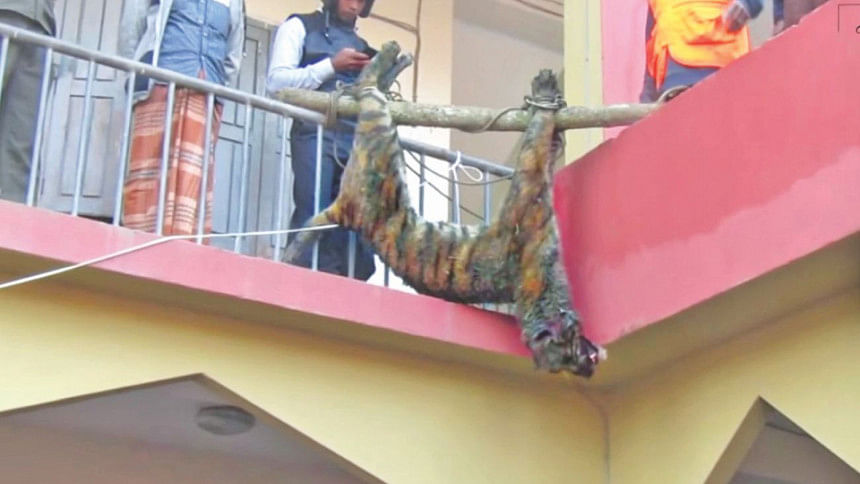The Sanctuary on its Death Bed

On January 23 this year, at around 6:00am, the inhabitants of Gulishakhali village awoke terrified to the blood-curdling howl of a Bengal Tiger very close to their village. Soon afterwards, the six-foot tiger was seen roaming freely around the village in the Morelganj upazila of Bagerhat district. It roared fiercely as it searched for food, and its frustrated hunger made it charge at doors of several houses, scaring their dwellers half to death. However, leaving only some scratch marks on the wooden doors, the tiger left in search for easier prey. Around that time, Sabbir Sardar was working in his shrimp farm when he noticed the predator approaching him and his labourers.
“I knew that a tiger had raided our village. But we had nowhere to go. Every door of every house was locked and we were totally exposed,” recounts Sabbir. In no time, the hungry tiger spotted his potential prey in the open shrimp farm and attacked. However, for Sabbir and his labourers, help was not far away. By then an announcement from the village mosque appealed to the villagers to chase the tiger away. Armed with bamboo sticks and machetes, the villagers soon surrounded the tiger, which was trying to kill Sabbir and his workers.
Repeated blows from the sticks and slashes with the machetes soon ended the life of the tiger already weakened by hunger. Sabbir and his four workers escaped with their lives and were sent to Khulna Medical College Hospital. And, the carcass of the unfortunate Bengal Tiger, a species that has been declared critically endangered in the International Union for Conservation of Nature (IUCN) red list, was hung up at the local union council office for public display.
It has become common for villagers living near the Sundarbans to kill Bengal Tigers. In the last 10 years, 13 have been killed in similar incidents in the east and west zones of the Sundarbans.

Hatem Ali, an elderly inhabitant of Gulishakhali village, says: “Incidents of tigers raiding villages are increasing day by day. 15 or 20 years ago, these were rare. We used to fear tiger attacks only when we went into the forest to collect honey or nipa palm.
“At present, tigers frequently come very close to the villages,which indicate that the forest is not in good condition. You know about tiger attacks on villagers only when we are forced to kill it or it kills one of us. But, currently we are living in constant danger. Although our village is six kilometres away from the Sundarbans, tigers still frequently venture very close. We killed a tiger in January but five days earlier, another tiger killed a pig just on the other side of this canal,” adds Hatem.
Md Bashirul Al Mamun, Divisional Forest Officer, Sundarbans West Zone, Khulna explains why tigers are entering populated areas. “It used to be the case that when a tiger became too sick or old, it raided villages for easier prey. However, in most recent incidents, we have noticed that raiding tigers are quite young. The tiger that was killed in Gulishakhali was only two-and-a-half years old, which means that it had just left its mother's care,” states Bashirul.
“The reason behind this incident is fragmentation of their habitat. When a tiger leaves its mother, it has to establish new territory. But the Pashur River and its channels are so frequently navigated by cargo vessels that tigers don't dare cross. This creates food shortage and territorial crises for tigers. As a result, they are forced to use localities for their movement and humans and cattle become their prey,” he explains.

Besides villagers, tigers are also killed in large numbers by poachers. According to Tiger Census 2004, the number of Bengal Tigers in the Sundarbans was 440. However, the census conducted in 2006-07 revealed that the number had dwindled to 200, and in 2015, it stood at a paltry 106. Experts and forest officials say that one of the key reasons behind the drastic fall is poaching. According to the Forest Department, body parts of at least 30 tigers have been discovered in different parts of the country from 2011 to 2016. Amir Hossain Chowdhury, Conservator of Forest, Khulna region says: “The poachers are infusing deer carcasses with Furadan pesticide to kill tigers. These poachers are very difficult to detect as they don't carry any weapons and enter the forest under the guise of forest gatherers. Nevertheless, we have introduced smart patrolling using GPS trackers to arrest the poachers and ensure proper enforcement of laws in the Sundarbans.”
The declining tiger population of the Sundarbans has made the existing forest more vulnerable to encroachment and pollution. At Joymonir Gol area on the bank of the Pashur River, huge swathes of land have been converted into massive shrimp farms. Just on the opposite bank of the river lies the Sundarbans. Ahmed Haji, a fisherman who has been plying Pashur River for more than 50 years, says: “Just two decades earlier, these lands, where shrimp farms have been established, were part of the Sundarbans. In these shrimp farms, the farmers use pesticides to kill fish that eat shrimp fries. This pesticide mixes with the Pashur River and ultimately contaminate the river water. There are thousands of shrimp farms in Bagerhat district. As a result, we don't find any fish in Pashur River and in its canals nowadays. We can only catch shrimp fries which we sell to these shrimp farms.”

Besides these pesticides, the herbicides and fungicides used by paddy farmers and fish farmers are also taking a toll on the forest ecosystem. “Farmers use huge amounts of dieldrin, endrin, atrazine and heptachlor as insecticides, herbicide and fungicide without knowing their impact on the ecosystem. Along with the agricultural department, we are trying to make them aware of the harmful impacts of these chemicals so that they use it in limited quantities,” Habibul Huq Khan, Director of Department of Environment, Khulna Division, informs.
According to experts, these chemicals can also jeopardise the forest itself when it enters the food chain. “Herbicides are notorious for contaminating ground water, river water and soil compound. Entering the food chain through water and soil nutrients, it can shorten lives of two of the Sunbarbans' key pollinators; the Giant Honey Bee and butterflies, especially the Sundarbans' Crow Butterfly. It can even kill them. Again, these poisonous chemicals—particularly insecticides—can eliminate the fish and crab population which save Sundarbans' trees by eating the algal colonies that grow on their aerial roots,” says Dr Monowar Hossain, Chairman, Zoology Department of Jahangirnagar University.
“For the survival and natural expansion of the Sundarbans, conservation of pollinators like Sundarbans Crow Butterfly and Giant Honey Bees is crucial,” he adds. However, no research has been conducted yet to assess the impact of poisonous agro-chemicals on the Sundarbans eco-system.
“There is no doubt that toxic agro-chemicals have extremely negative impacts on the food chain. But I didn't see any research on this important issue on the basis of which we could assess the impact and take preventive measures,” says Dr Manirul H Khan, wildlife specialist and associate professor, Zoology Department of Jahangirnagar University.

On the other hand, with rapid and unplanned industrialisation of Mongla area, the Sundarbans and its wildlife are becoming the worst-affected victims of industrial pollution. In the last four years, eight commercial cargo vessels carrying coal, oil and fertiliser sank in rivers running through the Sundarbans. Oil spillage and heavy metal contamination from these vessels have severely affected aquatic creatures, biodiversity and plants in the mangrove forest. The last of these eight accidents occurred in April 14, 2018, when a cargo ship carrying 775 tonnes of coal capsized in the Pashur River. It took two months to salvage the vessel, but more than 90 percent of its cargo of coal remained underwater as the vessel had to be emptied for the salvage operation.
“Due to these accidents, huge amounts of heavy metals like mercury, cadmium, nickel, lead and arsenic pollute the water and soil. These pollutants can change the biogeochemistry of mangrove sediments and physiology of mangrove species. Contaminating the food chain, these pollutants can cause the death of the forest's flora and fauna,” says Dr Manirul.
Despite several project-based initiatives to conserve Sundarbans and the Bengal Tiger, the largest mangrove forest of the world is on the brink of destruction due to sustained industrial pollution and encroachment. Encroachment by cargo vessels and expansion of heavy industries near the forest is fragmenting it, ultimately making it easier for poachers to infiltrate.
The destruction of this forest not only endangers some of the world's rarest species but also threatens the livelihood of more than four million people who depend directly on the Sundarbans for their livelihood. “More than 50 percent of the Sundarbans has been declared wildlife sanctuary, which is a very good initiative. But now the time has come to protect the buffer areas of the Sundarbans. If we can't protect the villages, rivers and canals bordering Sundarbans from pollution and industrialisation, we will not be able to save the forest,” opines Dr Manirul.
Due to pollution, deforestation and industrialisation, a huge number of fishermen, farmers and forest gatherers have lost their livelihoods over the last couple of decades. These jobless, homeless and oppressed people are desperately seeking income from shrimp fry harvesting, poaching or pirating. To explore their struggling and precarious lives, read our article “The Invisible Victims of 'Development'” by the same author at pages 17-19.
The writer can be contacted [email protected]

 For all latest news, follow The Daily Star's Google News channel.
For all latest news, follow The Daily Star's Google News channel. 



Comments